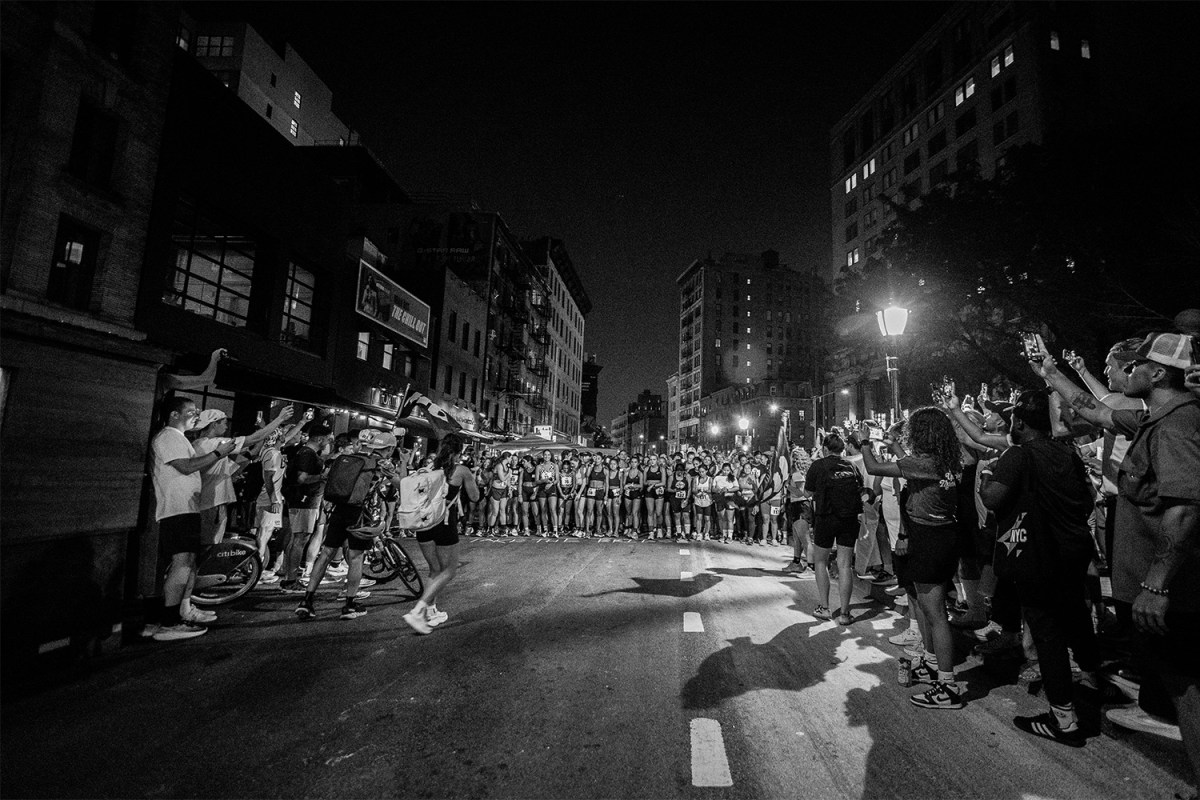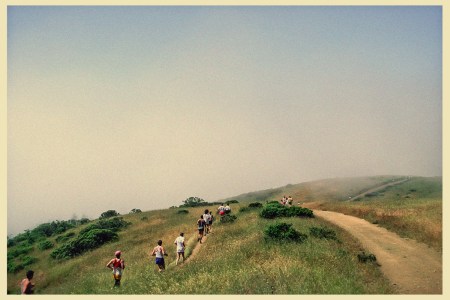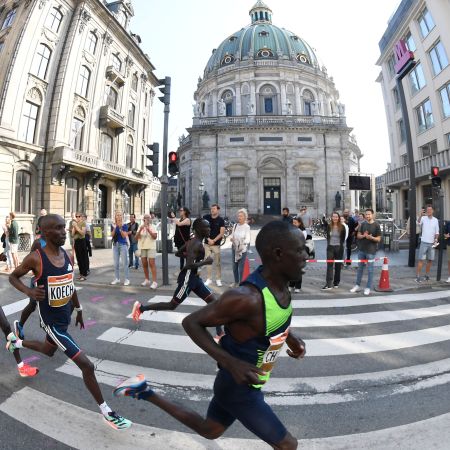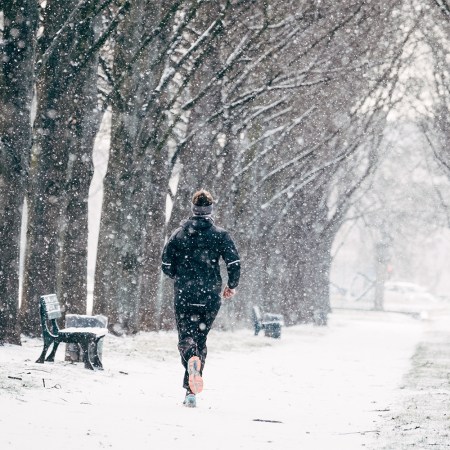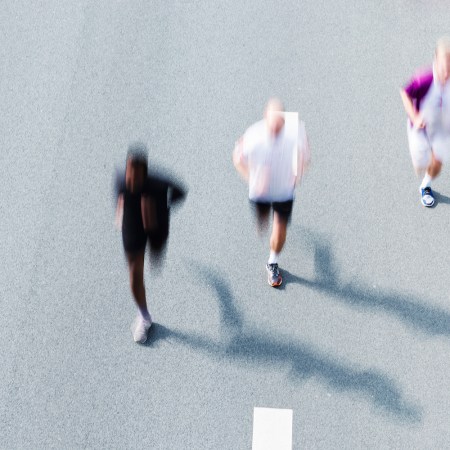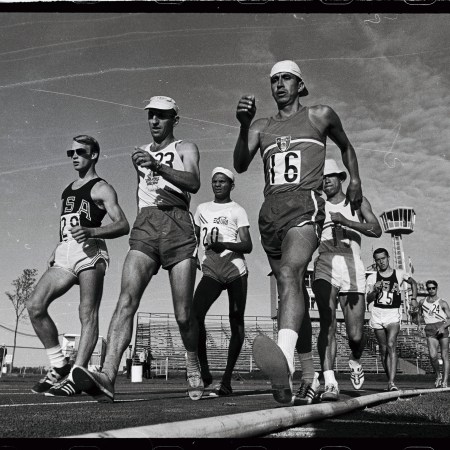The idea started, appropriately enough, on a bridge. This was back in 2015 when Darcy Budworth, then 34, was working in Manhattan and living in Brooklyn. “At the time, I was working crazy hours at an architecture firm, not finishing work until 11 or 12 p.m.,” Budworth explains.
Her firm offered to pay for taxis home, but after spending all day cooped up at a desk, Budworth saw her late-night commute as the perfect time to get her run in. “I was always running over bridges,” she says. “I have always loved the bridges in New York, and always thought that they were this one moment of calm in this crazy city.”
Budworth moved to New York from Portland, Oregon, in 2004. Like most runners new to the city, she joined a local team. Hers happened to be the New York Harriers, a club which fell under the umbrella of the New York Road Runners. Founded in 1958, the Road Runners group now has more than 60,000 members, and is involved in the organization of the New York City Marathon, one of the biggest road races in the world. “Honestly, at this point, they kind of feel like a big corporation,” says Budworth, who quickly tired of following the NYRR-organized loops around Central Park weekend after weekend.
In need of fresh inspiration, she happened across the Orchard Street Runners, a smaller group that organized unsanctioned runs through city streets. “It wasn’t like any kind of a workout, it was just like, run through the streets, run with the lights, run against traffic, try to not get hit and run as fast as you can,” she enthuses. “And it was just really fucking exciting.”
The Globetrotting Guidebook: Our Most Memorable Runs Across the Planet
A powerhouse panel of pro runners, legendary coaches and race directors share the routes they’ll never forgetShe found the same energy when competing in David Trimble’s 5K running races, which he tacked on to to his renowned cycling series, Red Hook Criterium, in 2012. After Trimble partnered with one of the organizers from Orchard Street Runners to put on the Midnight Half later that same year, Budworth realized how sorely the city needed the sort of unsanctioned and engaging races that served the local endurance community.
“I think of these races like local businesses compared to big corporations,” she says. “The idea that we’re from the local community and we know what local people need is powerful. It’s this idea of locals coming together and throwing a race. If you’re not getting it from the big corporations, you have to step in and do it yourself.”
Budworth came up with the name for Take The Bridge while sitting in a bar with her ex. The first race launched in 2015. It has since spread to other cities, including Chicago, Austin, Montreal, Nashville, Boston, Miami, Boulder, Denver and San Diego. In other words, if there’s a big bridge near you, there’s a good chance Darcy Budworth is currently figuring out how to run over it. There have been cycling editions, hugely popular women-only editions, and, in 2021, a new trail-focused spinoff called Take The Ridge. It keeps growing; last year was the biggest year yet, with over 900 runners taking part.
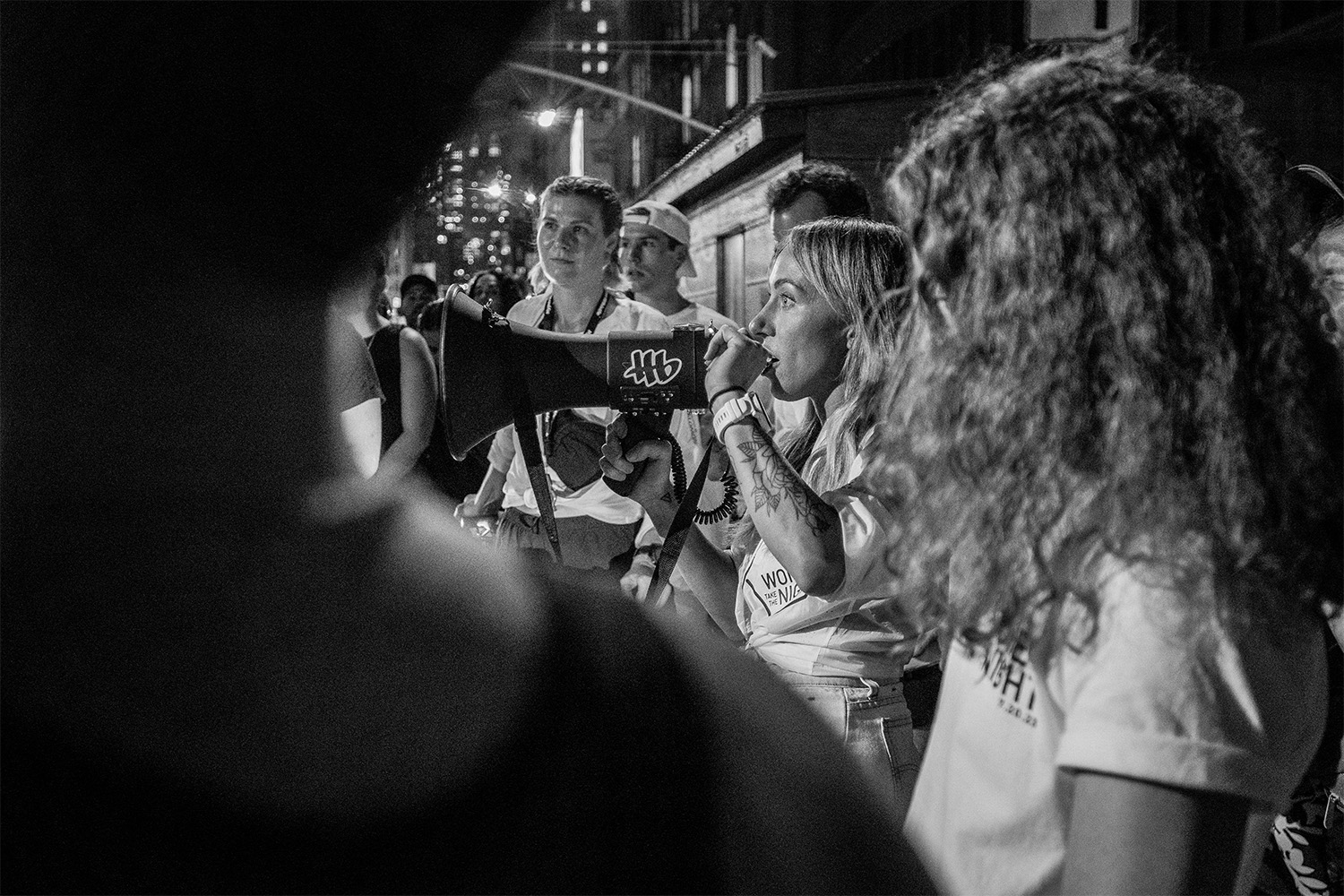
Taking It to the Streets
Starting at a chalk line, runners in any Take The Bridge race are given an endpoint (almost always a bar), a specific number of bridges they must cross, and a handful of other checkpoints they have to hit, along a roughly 10-kilometer trail. The rest is up to them, making the race as much about navigation and swerving past pedestrians as it is about bolting to a finish line. Most of the races are limited to fewer than 100 runners, and announced at short notice. They rapidly sell out on Eventbrite.
“We don’t normally announce them until two weeks before, so you can’t really get ready for them,” adds Budworth. “The idea is that you bring yourself at whatever level you’re currently at.”
“Unsanctioned racing provides something alternative…many of us have loved both the traditional ways of running and the weird, funky, different ideas about what it could be,” says Jessie Zapo, an artist and performance coach who founded women’s running collective Girls Run NYC and first met Budworth through Orchard Street Runners. “It’s fun to do something that’s not the norm, that not everyone does and that defies a lot of the rules.”
“Participating in my first Take The Bridge, I felt true freedom in the sport for the first time since I was a child.”
Erin Jaskot, who has competed in five TTB races
For some runners, the free-form flow of Take The Bridge can provide a much-needed shock to the system. You might be knee-deep in marathon training when one of their races is announced, or maybe you’re working hard to get your mile time down. Take The Bridge is an antidote to all that, well, work.
“There’s a certain point where you have to remind yourself that running is supposed to be fucking fun,” says Budworth. “You have to come back to these moments where you get out of your element, throw your training book aside and just do something to get out of your element and have a good time.”
Erin Jaskot ran her first Take The Bridge in Greenpoint, Brooklyn, in 2021. Before that, she’d been running collegiately for Villanova University and Mount Saint Mary’s — all the while longing for something freer.
“When I was in college, I would be scrolling Instagram and see these underground-style races popping up like Take The Bridge, The Speed Project, O.P.A.C. Relays and Hood to Coast. I felt this longing to participate, but as a college athlete you have to abide to a strict racing schedule and training plan,” she says. “But this style of racing felt aligned with my soul, and I knew that once I was out of college, I would join them. Participating in my first Take The Bridge, I felt true freedom in the sport for the first time since I was a child. It’s a race where the only thing that matters is competing, being with your environment and having fun. Just true and honest racing.” To date, Jaskot has competed in five Take The Bridge races.
While Take The Bridge attracts some of the best runners around, like Jaskot and Zapo, in its unique format, it offers a much needed sense of democratization, too. “Something that’s fun is that the fastest people who usually win every race they enter, they might not actually win our races because it’s about more than that, it’s about thinking on your toes, navigating and knowing the city you’re in — all of which serves to level the playing field,” Budworth says.
As to why her series has proven so popular — it currently has over 23,000 followers on Instagram, many of whom eagerly await news of the next race — Budworth says, “I think it’s just this gritty thing that people find really sexy. There’s an energy that you see at these races, that it’s just exciting to go and be a part of it.”
“A lot of people criticize our sport because the emphasis has been shifting to times on the clock, instead of true racing,” adds Jaskot. “Take The Bridge reconnects us to a human vs. human competition, instead of human vs. the clock. Our sport needs more of this, otherwise it can become stale. With Take The Bridge, you focus on the here and now, breaking free of the rigidity that running sometimes imposes on us.”
The small race size and the after-parties help foster a sense of community, too — especially among female runners. Zapo has been involved in unsanctioned running for over 20 years, but says too often the sport felt male-dominated. “Darcy being a woman race director has been extremely inspirational to a lot of women and has also brought a different sensibility to unsanctioned racing,” she says. “I think she’s worked really hard to make unsanctioned racing accessible and inclusive.”
Dispatches From the Wildest Marathon You’ve Never Heard Of
What it’s like to run 26.2 with Nick Bare on a private ranch outside AustinRun-Ins With the Law
Naturally, an unsanctioned race originating in one of the world’s most heavily policed cities is not without its difficulties. “Unsanctioned” means Budworth and her colleagues don’t get permits or permission from anyone before throwing their races. Sometimes the cops are not happy — which all adds to the vibe.
“There’s been a couple of times where we’ve had to deal with the cops,” Budworth says. “We threw a race in Miami for Art Basel and we went over this one bridge to a shipping area I had scouted many times on my bike and never gotten in trouble, but apparently it’s private property.”
One of the race’s checkpoints was underneath the bridge. Budworth got a call that police were turning runners away and cycled ahead to talk to them. “We basically had to negotiate, mid-race,” she says. In the end, the checkpoint was moved to one side of the bridge instead of beneath it and Budworth did, in fact, manage to win the cops over, with the law even taking over duties marking people with felt tip to show they’d completed the checkpoint. “It was hilarious that these cops decided that they wanted to take over the checkpoint,” she says.
In other races, police have approached Budworth a few checkpoints in, saying other runners need to hurry or they’re shutting the race down. In Eugene, Oregon, Budworth put on a race during the 2022 World Athletics Championships. City officials found out and, overloaded with logistics for the global event, were understandably pissed off. They called Budworth directly and tried to nix the race. She moved the start location, telling runners they could only share the details with people they trusted. The race went ahead, and they had no problems with the authorities.
“I put a lot of work into these races to make sure that we don’t fuck anything up,” she says. “Obviously, there’s going to be things that don’t go 100% to plan, but because I’ve been doing this for so long, I just have a way of making sure things don’t fall apart on the night.”
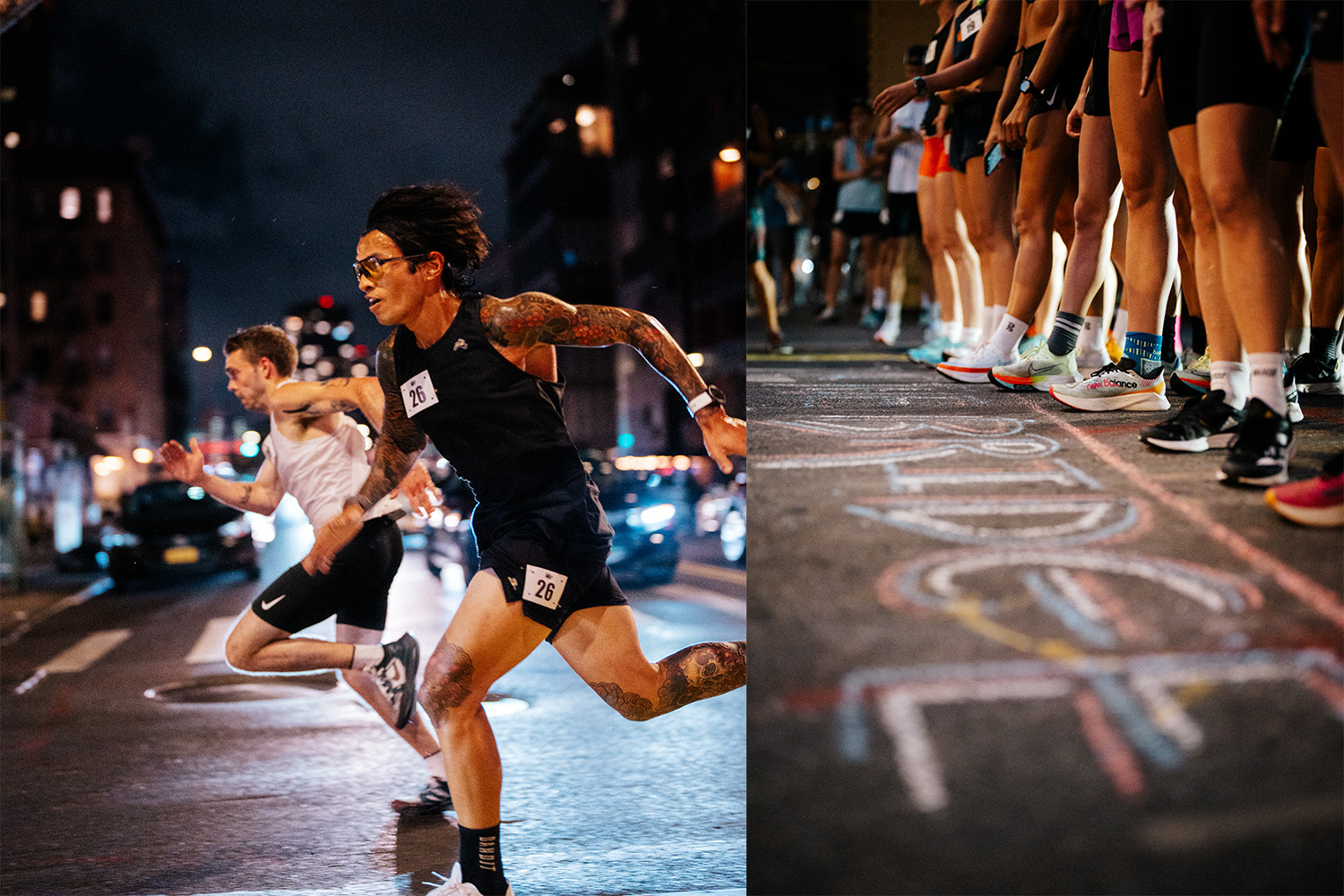
What’s Next for Take The Bridge
If all of that sounds exhausting, well, it kind of is. Take The Bridge continues to grow, with a particularly massive year during COVID when all that most of us could do was get outside for an hour to run. During our conversation in January 2024, Budworth estimates that she’s been on the road for the past two and a half years, throwing one race after another, with no time off. While she says it’s exciting that the series has become so popular, it isn’t allowing her time to sit down and figure out what’s working and what could use some tweaking.
To rectify this, she’s taken the first quarter of the year off to ask herself, “How are we gonna to move forward? And to really think clearly and thoughtfully about where how we’re gonna progress.” Don’t worry, there will still be races this year, but not until April.
Behind the scenes, Budworth has been talking to Salomon (which sponsored the Take The Ridge race), as well as other brands about what the future of the series might look like. She’s keen to put on more races in Canada and London. Other than that, 2024 might be a year of focusing on New York and L.A. — trialing new approaches there before spreading out again.
“What I like to tell people is that I’m learning and just making shit up as I go,” she says. “There’s no guidebook as to how to throw unsanctioned races. I learn a lesson here and I apply it going forward. The whole idea is to not make the same mistake twice, right? We’re all learning. We’re all shifting and adjusting.”
Whether you’re looking to get into shape, or just get out of a funk, The Charge has got you covered. Sign up for our new wellness newsletter today.
